Difference between revisions of "Bellows"
(Rewrite of the first part; interim save) |
(interim save) |
||
| Line 11: | Line 11: | ||
==Bellows as a permanent part of the camera== | ==Bellows as a permanent part of the camera== | ||
===Compactness=== | ===Compactness=== | ||
| − | The simplest use of bellows is to achieve ''compactness'' in a folding camera. The bellows extend to form part of the lightproof body of the camera while in use, and retract into a very compact size inside the rigid part of the body when the camera is folded. | + | The simplest use of bellows is to achieve ''compactness'' in a folding camera. The bellows extend to form part of the lightproof body of the camera while in use, and retract into a very compact size inside the rigid part of the body when the camera is folded. <!--Add comparison pictures of a folder open and closed; small --> |
| + | |||
| + | If the bellows is not involved in focusing (see below), then unfolding the camera requires only that the bellows be extended to the same fixed position each time. Most folding cameras of this sort have a folding strut mechanism associated with the front door, which serves to hold the lens standard more or less rigidly in the correct position when the camera is unfolded. Many folding cameras, especially later ones, are 'self-erecting'; that is the lens standard and bellows are automatically put in position when the door is released. | ||
| + | |||
| + | Other arrangements also occur. In 'strut-folding' cameras such as the [[Foth Derby]] the lens board is simply pulled out from the body to a more or less definite fixed position for use. | ||
===Focusing=== | ===Focusing=== | ||
| − | The variable extension of the bellows is used to provide the ''focusing'' in some cameras. This is most familiar as a feature of view cameras, with a ground glass screen, but bellows focusing is also used with [[rangefinder]] cameras (for example the Speed Graphic) and [[SLR]]s such as the [[Mamiya RB67]]. Some folding cameras use bellows focusing with no other aid than a scale fixed alongside the lens standard. | + | The variable extension of the bellows is used to provide the ''focusing'' in some cameras. This is most familiar as a feature of view cameras, with a ground glass screen, but bellows focusing is also used with [[rangefinder]] cameras (for example the Speed Graphic) and [[SLR]]s such as the [[Mamiya RB67]]. Some folding cameras use bellows focusing with no other aid than a scale fixed alongside the lens standard. <!--picture of a camera's focus scale on the bed--> |
| − | + | In folding bellows-focusing cameras the front door usually opens to form a focusing bed, with rails upon which the lens standard moves. | |
| − | + | Some [[SLR]] bellows cameras such as the [[Soho Reflex]], the [[Mamiya RB67|RB67]] and the [[Rolleiflex SL66]] use a rack-and-pinion system for focusing instead of a baseboard and rails, with a pair of toothed racks attached to the front board of the camera. Their purpose is the same however; because of the flexibility of the bellows, some rigid mechanical system is needed to hold it at the right extension. <!--picture of one of these, with the racks visible--> | |
| + | A special case are monorail cameras, a type of view camera in which the 'body' comprises little more than the bellows and rails. <!--picture of a monorail, and add its name to the text--> | ||
===Camera movements=== | ===Camera movements=== | ||
| − | The most advanced use of bellows is to allow ''camera movements'': rise and fall, left and right shift, tilt and swing. These movements allow advanced control of the plane of focus, and of perspective. Again, camera movements are most frequently a feature of view cameras, but ''rise'' in particular is often available on other bellows cameras, even in some where there is no way to judge the effect. | + | The most advanced use of bellows is to allow ''camera movements'': rise and fall, left and right shift, tilt and swing. These movements allow advanced control of the plane of focus, and of perspective. Again, camera movements are most frequently a feature of view cameras, but front ''rise'' in particular is often available on other bellows cameras, even in some where there is no way to judge the effect. |
| + | The bellows itself only maintains the lightproof enclosure by its felxibility. It is mechanical systems associated with the lens standard and/or the back-plate that achieve the camera movements. | ||
==Bellows accessories== | ==Bellows accessories== | ||
| − | + | On a rigid camera with interchangeable lenses, a bellows fitted between the camera body and the lens can extend the lenses' close focus capabilities (the further the lens is from the film, the closer it is focused). The length of the bellows is controlled by one or more rails. It serves exactly the same function as an extension tube, but can be adjusted to any length (up to that of its rails). As with most lens accessories, the bellows must be of the correct lens mount for the camera. Most makers of system cameras have provided bellows that support automatic aperture stopdown. | |
| + | <!--Find out about compendium hoods; why do people use them--> | ||
{{br}} | {{br}} | ||
{{Flickr_image | {{Flickr_image | ||
Revision as of 03:55, 17 May 2011
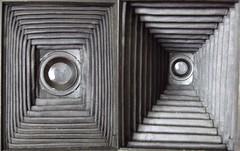
Left: folded bellows of a folding camera seen through
opened camera back. Right: same bellows unfolded
A bellows[1] is a lightproof tube, rectangular in section, made from an opaque, flexible material (leather, leatherette, vinyl, etc.), with lateral folds that allow it to retract or extend in length.
Bellows are used in several ways:
- They are a permanent part of the body of some cameras.
- A bellows is also an accessory for close-up photography, essentially an extension tube of variable length.
- A bellows lens hood (or compendium hood) is a hood of adjustable depth, used with view cameras or sometimes with SLRs.
Contents
Bellows as a permanent part of the camera
Compactness
The simplest use of bellows is to achieve compactness in a folding camera. The bellows extend to form part of the lightproof body of the camera while in use, and retract into a very compact size inside the rigid part of the body when the camera is folded.
If the bellows is not involved in focusing (see below), then unfolding the camera requires only that the bellows be extended to the same fixed position each time. Most folding cameras of this sort have a folding strut mechanism associated with the front door, which serves to hold the lens standard more or less rigidly in the correct position when the camera is unfolded. Many folding cameras, especially later ones, are 'self-erecting'; that is the lens standard and bellows are automatically put in position when the door is released.
Other arrangements also occur. In 'strut-folding' cameras such as the Foth Derby the lens board is simply pulled out from the body to a more or less definite fixed position for use.
Focusing
The variable extension of the bellows is used to provide the focusing in some cameras. This is most familiar as a feature of view cameras, with a ground glass screen, but bellows focusing is also used with rangefinder cameras (for example the Speed Graphic) and SLRs such as the Mamiya RB67. Some folding cameras use bellows focusing with no other aid than a scale fixed alongside the lens standard.
In folding bellows-focusing cameras the front door usually opens to form a focusing bed, with rails upon which the lens standard moves.
Some SLR bellows cameras such as the Soho Reflex, the RB67 and the Rolleiflex SL66 use a rack-and-pinion system for focusing instead of a baseboard and rails, with a pair of toothed racks attached to the front board of the camera. Their purpose is the same however; because of the flexibility of the bellows, some rigid mechanical system is needed to hold it at the right extension.
A special case are monorail cameras, a type of view camera in which the 'body' comprises little more than the bellows and rails.
Camera movements
The most advanced use of bellows is to allow camera movements: rise and fall, left and right shift, tilt and swing. These movements allow advanced control of the plane of focus, and of perspective. Again, camera movements are most frequently a feature of view cameras, but front rise in particular is often available on other bellows cameras, even in some where there is no way to judge the effect. The bellows itself only maintains the lightproof enclosure by its felxibility. It is mechanical systems associated with the lens standard and/or the back-plate that achieve the camera movements.
Bellows accessories
On a rigid camera with interchangeable lenses, a bellows fitted between the camera body and the lens can extend the lenses' close focus capabilities (the further the lens is from the film, the closer it is focused). The length of the bellows is controlled by one or more rails. It serves exactly the same function as an extension tube, but can be adjusted to any length (up to that of its rails). As with most lens accessories, the bellows must be of the correct lens mount for the camera. Most makers of system cameras have provided bellows that support automatic aperture stopdown.
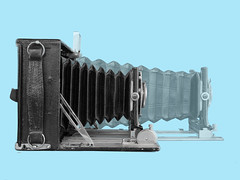
|
| Principle of Double Expansion Bellows image by Dirk HR Spennemann (Image rights) |

|

|
The average folding camera unfolds its bellows to a fixed length. Some models with exchangeable lenses allow different bellows expansion lengths. Some sophisticated amateur cameras allow tilts and shifts, but in most amateur cameras the bellows is just optimized for the compactness of the folded camera.

|
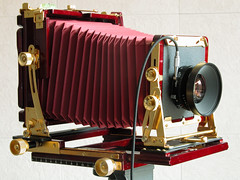
|
| Bellows for macro photography with modern SLRs are geometrically more like accordion bellows than like typical built-in camera bellows. That means a macro bellows has an equal diameter throughout its length. |
The bellows of professional view cameras are also accordion-bellows-like or with only little reduction of diameter towards the lens mount plate. That gives these bellows better flexibility for tilting and shifting the lens to reach optimal image geometry and sharpness plane. But some amateur plate cameras offer such lens board flexibility too, despite of non-accordion bellows geometry. |
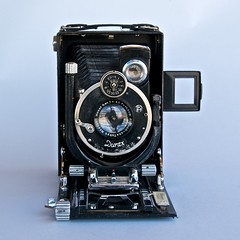
|
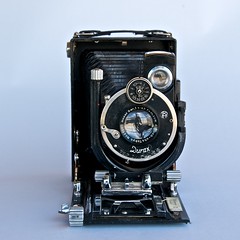
|
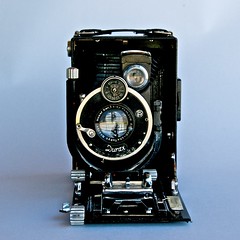
|
|

|
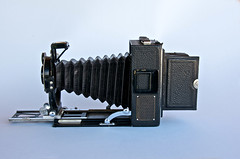
|
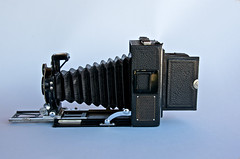
|
|
| Lens board movements Konishiroku Lily, 6.5×9cm with Hexar Ser.1 10.5cm f/4.5 lens in Durax shutter, Images by Dirk HR Spennemann (Image rights) | |||

|
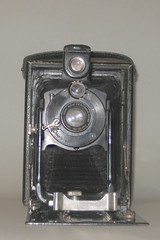
|
| lens board centered | lens board raised |
Notes
- ↑ Bellows is both the singular and the plural.